MT Generate Fading Profile VI
Generates a user-specified Rayleigh or Rician fading profile for the complex baseband waveform. Call the MT Apply Fading Profile VI to apply the generated profile to a baseband I/Q waveform. You can use this VI for modeling Rayleigh and Rician fading profile distributions using Gans and Jakes models for characterizing flat-fading channels and time-varying frequency selective-fading channels.
Use the pull-down menu to select an instance of this VI.
MT Rayleigh Fading profile (Jakes)
This polymorphic instance generates a Rayleigh flat-fading profile with an envelope that statistically obeys the Rayleigh distribution, using the Jakes fading model.
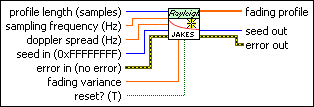
 |
profile length specifies the number of complex-valued fading profile samples (having Rayleigh-distributed envelopes) to generate. The default is 1,000. |
||||||
 |
sampling frequency specifies the system sampling rate, in hertz. This rate is the product of the symbol rate × samples per symbol. The default is 1.0. |
||||||
 |
doppler spread specifies the desired input Doppler spread f m of the channel, in hertz. The default is 100.00 mHz. This parameter denotes the measure of the spectral broadening caused by the time rate of change of the channel. Doppler spread is defined as the range of frequencies over which the received Doppler spectrum is essentially nonzero. When a pure sine tone at frequency f c is transmitted, the received signal spectrum, called the Doppler spectrum, has components in the range (f c – f m) to (f c + f m). The Doppler spread is related to the mobile velocity v, carrier frequency f c, and the speed of light c by the relation f m = v f c/c.
|
||||||
 |
seed in specifies the initial state for generating the fading profile. If seed in is set to –1, the generated fading profile is randomly chosen during every call when reset? is set to TRUE. Otherwise, the generated fading profile returns the same set of fading coefficients when reset? is set to TRUE. The seed in value is used only for the first call or when reset? is set to TRUE. The default is –1. |
||||||
 |
fading variance specifies the desired variance of the complex-valued Rayleigh distributed fading profile. The default is 1.0. |
||||||
 |
reset? specifies whether the fading profile generation is reset on subsequent calls to this VI. When reset? is set to TRUE, fading profile generation is reset on every call to this VI. Set reset? to FALSE to continue generating the fading profile from the previous iteration on subsequent calls. The default is TRUE. |
||||||
 |
error in (no error) can accept error information wired from previously called VIs. Use this information to decide if any functionality should be bypassed in the event of errors from other VIs. Right-click the front panel error in control and select Explain Error or Explain Warning from the shortcut menu for more information about the error.
|
||||||
 |
fading profile returns complex-valued coefficients of the generated fading profile size that equals profile length. Wire this parameter to the MT Apply Fading Profile VI to apply this fading profile to a baseband I/Q signal. |
||||||
 |
seed out returns the internal state of the VI at the end of generation of the fading profile for the current iteration. |
||||||
 |
error out passes error or warning information out of a VI to be used by other VIs. Right-click the front panel error out indicator and select Explain Error or Explain Warning from the shortcut menu for more information about the error.
|
MT Rayleigh Fading profile (Gans)
This polymorphic instance generates a Rayleigh flat-fading profile with an envelope that statistically obeys the Rayleigh distribution, using the Gans fading model.

 |
profile length specifies the number of complex-valued fading profile samples (having Rayleigh-distributed envelopes) to generate. The default is 1,000. |
||||||
 |
sampling frequency specifies the system sampling rate, in hertz. This rate is the product of the symbol rate × samples per symbol. The default is 1.0. |
||||||
 |
doppler spread specifies the desired input Doppler spread f m of the channel, in hertz. The default is 100.00 mHz. This parameter denotes the measure of the spectral broadening caused by the time rate of change of the channel. Doppler spread is defined as the range of frequencies over which the received Doppler spectrum is essentially nonzero. When a pure sine tone at frequency f c is transmitted, the received signal spectrum, called the Doppler spectrum, has components in the range (f c – f m) to (f c + f m). The Doppler spread is related to the mobile velocity v, carrier frequency f c, and the speed of light c by the relation f m = v f c/c.
|
||||||
 |
seed in specifies the initial state for generating the fading profile. If seed in is set to –1, the generated fading profile is randomly chosen during every call when reset? is set to TRUE. Otherwise, the generated fading profile returns the same set of fading coefficients when reset? is set to TRUE. The default is –1. |
||||||
 |
fading variance specifies the desired variance of the complex-valued Rayleigh distributed fading profile. The default is 1.0. |
||||||
 |
reset? specifies whether the fading profile generation is reset on subsequent calls to this VI. When reset? is set to TRUE, fading profile generation is reset on every call to this VI. Set reset? to FALSE to continue generating the fading profile from the previous iteration on subsequent calls. The default is TRUE. |
||||||
 |
error in (no error) can accept error information wired from previously called VIs. Use this information to decide if any functionality should be bypassed in the event of errors from other VIs. Right-click the front panel error in control and select Explain Error or Explain Warning from the shortcut menu for more information about the error.
|
||||||
 |
fading profile returns complex-valued coefficients of the generated fading profile size that equals profile length. Wire this parameter to the MT Apply Fading Profile VI to apply this fading profile to a baseband I/Q signal. |
||||||
 |
seed out returns the internal state of the VI at the end of generation of the fading profile for the current iteration. When reset? is set to FALSE, this state is used to continue the fading profile generation at the beginning of the next iteration. |
||||||
 |
error out passes error or warning information out of a VI to be used by other VIs. Right-click the front panel error out indicator and select Explain Error or Explain Warning from the shortcut menu for more information about the error.
|
MT Rician Fading profile (Jakes)
This polymorphic instance generates a Rician flat-fading profile whose envelope statistically obeys the Rician distribution, using the Jakes fading model.
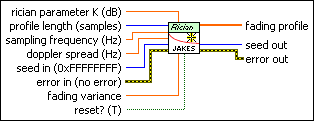
 |
profile length specifies the number of complex-valued fading profile samples (having Rician-distributed envelopes) to generate. The default is 1,000. |
||||||
 |
sampling frequency specifies the system sampling rate, in hertz. This rate is the product of the symbol rate × samples per symbol. The default is 1.0. |
||||||
 |
doppler spread specifies the desired input Doppler spread f m of the channel, in hertz. The default is 100.00 mHz. This parameter denotes the measure of the spectral broadening caused by the time rate of change of the channel. Doppler spread is defined as the range of frequencies over which the received Doppler spectrum is essentially nonzero. When a pure sine tone at frequency f c is transmitted, the received signal spectrum, called the Doppler spectrum, has components in the range (f c – f m) to (f c + f m). The Doppler spread is related to the mobile velocity v, carrier frequency f c, and the speed of light c by the relation f m = v f c/c.
|
||||||
 |
seed in specifies the initial state for generating the fading profile. If seed in is set to –1, the generated fading profile is randomly chosen during every call when reset? is set to TRUE. Otherwise, the generated fading profile returns the same set of fading coefficients when reset? is set to TRUE. The seed in value is used only for the first call or when reset? is set to TRUE. The default is –1. |
||||||
 |
rician parameter K specifies the desired ratio,in dB, of the dominant line-of-sight (LOS) path to the scattering component. A large positive value of K represents a strongly additive white Gaussian noise channel, while a large negative value of K represents a Rayleigh fading (predominantly scattering) channel. Mathematically, the Rician parameter K is defined as K (dB) = 10 × log{Power[LOS component]/Power[scattering component]} The Rician fading profile is generated by adding a DC specular component to a Rayleigh distributed scattering component. var denotes the requested fading variance — the variance of the underlying Rayleigh fading profile. The amplitude of the specular DC component equals
By varying K, you can control the extent of the scattering component relative to the LOS component of fading. For a strongly Gaussian channel, K approaches infinity, while K < 0 indicates a strongly scattering (Rayleigh fading) channel. The default is 0 dB. |
||||||
 |
fading variance specifies the desired variance of the complex-valued Rician distributed fading profile. The default is 1.0. |
||||||
 |
reset? specifies whether the fading profile generation is reset on subsequent calls to this VI. When reset? is set to TRUE, fading profile generation is reset on every call to this VI. Set reset? to FALSE to continue generating the fading profile from the previous iteration on subsequent calls. The default is TRUE. |
||||||
 |
error in (no error) can accept error information wired from previously called VIs. Use this information to decide if any functionality should be bypassed in the event of errors from other VIs. Right-click the front panel error in control and select Explain Error or Explain Warning from the shortcut menu for more information about the error.
|
||||||
 |
fading profile returns complex-valued coefficients of the generated fading profile size that equals profile length. Wire this parameter to the MT Apply Fading Profile VI to apply this fading profile to a baseband I/Q signal. |
||||||
 |
seed out returns the internal state of the VI at the end of generation of the fading profile for the current iteration. |
||||||
 |
error out passes error or warning information out of a VI to be used by other VIs. Right-click the front panel error out indicator and select Explain Error or Explain Warning from the shortcut menu for more information about the error.
|
MT Rician Fading profile (Gans)
This polymorphic instance generates a Rician flat-fading profile for the multipath channel. The envelope for the first path statistically obeys the Rician distribution, while the envelope for the remaining path obeys the Rayleigh distribution implemented using the Gans model.
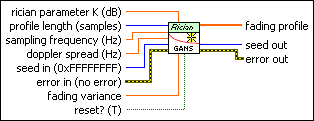
 |
profile length specifies the number of complex-valued fading profile samples (having Rician-distributed envelopes) to generate. The default is 1,000. |
||||||
 |
sampling frequency specifies the system sampling rate, in hertz. This rate is the product of the symbol rate × samples per symbol. The default is 1.0. |
||||||
 |
doppler spread specifies the desired input Doppler spread f m of the channel, in hertz. The default is 100.00 mHz. This parameter denotes the measure of the spectral broadening caused by the time rate of change of the channel. Doppler spread is defined as the range of frequencies over which the received Doppler spectrum is essentially nonzero. When a pure sine tone at frequency f c is transmitted, the received signal spectrum, called the Doppler spectrum, has components in the range (f c – f m) to (f c + f m). The Doppler spread is related to the mobile velocity v, carrier frequency f c, and the speed of light c by the relation f m = v f c/c.
|
||||||
 |
seed in specifies the initial state for generating the fading profile. If seed in is set to –1, the generated fading profile is randomly chosen during every call when reset? is set to TRUE. Otherwise, the generated fading profile returns the same set of fading coefficients when reset? is set to TRUE. The default is –1. |
||||||
 |
rician parameter K specifies the desired ratio,in dB, of the dominant line-of-sight (LOS) path to the scattering component. A large positive value of K represents a strongly additive white Gaussian noise channel, while a large negative value of K represents a Rayleigh fading (predominantly scattering) channel. Mathematically, the Rician parameter K is defined as K (dB) = 10 × log{Power[LOS component]/Power[scattering component]} The Rician fading profile is generated by adding a DC specular component to a Rayleigh distributed scattering component. var denotes the requested fading variance — the variance of the underlying Rayleigh fading profile. The amplitude of the specular DC component equals
By varying K, you can control the extent of the scattering component relative to the LOS component of fading. For a strongly Gaussian channel, K approaches infinity, while K < 0 indicates a strongly scattering (Rayleigh fading) channel. The default is 0 dB. |
||||||
 |
fading variance specifies the desired variance of the complex-valued Rician distributed fading profile. The default is 1.0. |
||||||
 |
reset? specifies whether the fading profile generation is reset on subsequent calls to this VI. When reset? is set to TRUE, fading profile generation is reset on every call to this VI. Set reset? to FALSE to continue generating the fading profile from the previous iteration on subsequent calls. The default is TRUE. |
||||||
 |
error in (no error) can accept error information wired from previously called VIs. Use this information to decide if any functionality should be bypassed in the event of errors from other VIs. Right-click the front panel error in control and select Explain Error or Explain Warning from the shortcut menu for more information about the error.
|
||||||
 |
fading profile returns complex-valued coefficients of the generated fading profile size that equals profile length. Wire this parameter to the MT Apply Fading Profile VI to apply this fading profile to a baseband I/Q signal. |
||||||
 |
seed out returns the internal state of the VI at the end of generation of the fading profile for the current iteration. When reset? is set to FALSE, this state is used to continue the fading profile generation at the beginning of the next iteration. |
||||||
 |
error out passes error or warning information out of a VI to be used by other VIs. Right-click the front panel error out indicator and select Explain Error or Explain Warning from the shortcut menu for more information about the error.
|
MT Rician Selective Fading profile (Gans)
This polymorphic instance generates a Rician selective fading profile for the multipath channel. The envelope for the first path statistically obeys the Rician distribution, while the envelope for the remaining path obeys the Raleigh distribution implemented using the Gans model.
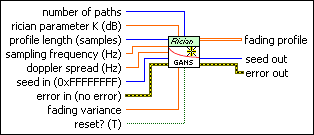
 |
profile length specifies the number of complex-valued fading profile samples (having Rician-distributed envelopes) to generate. The default is 1,000. |
||||||
 |
sampling frequency specifies the system sampling rate, in hertz. This rate is the product of the symbol rate × samples per symbol. The default is 1.0. |
||||||
 |
doppler spread specifies the desired input Doppler spread f m of the channel, in hertz. The default is 100.00 mHz. This parameter denotes the measure of the spectral broadening caused by the time rate of change of the channel. Doppler spread is defined as the range of frequencies over which the received Doppler spectrum is essentially nonzero. When a pure sine tone at frequency f c is transmitted, the received signal spectrum, called the Doppler spectrum, has components in the range (f c – f m) to (f c + f m). The Doppler spread is related to the mobile velocity v, carrier frequency f c, and the speed of light c by the relation f m = v f c/c.
|
||||||
 |
seed in specifies the initial state for generating the fading profile. If seed in is set to –1, the generated fading profile is randomly chosen during every call when reset? is set to TRUE. Otherwise, the generated fading profile returns the same set of fading coefficients when reset? is set to TRUE. The default is –1. |
||||||
 |
number of paths specifies the number of paths in the simulated multipath channel. A fading profile is generated for each of these paths. |
||||||
 |
rician parameter K specifies the desired ratio,in dB, of the dominant line-of-sight (LOS) path to the scattering component. A large positive value of K represents a strongly additive white Gaussian noise channel, while a large negative value of K represents a Rayleigh fading (predominantly scattering) channel. Mathematically, the Rician parameter K is defined as K (dB) = 10 × log{Power[LOS component]/Power[scattering component]} The Rician fading profile is generated by adding a DC specular component to a Rayleigh distributed scattering component. var denotes the requested fading variance — the variance of the underlying Rayleigh fading profile. The amplitude of the specular DC component equals
By varying K, you can control the extent of the scattering component relative to the LOS component of fading. For a strongly Gaussian channel, K approaches infinity, while K < 0 indicates a strongly scattering (Rayleigh fading) channel. The default is 0 dB. |
||||||
 |
fading variance specifies the desired variance of the complex-valued Rician distributed fading profile. The default is 1.0. |
||||||
 |
reset? specifies whether the fading profile generation is reset on subsequent calls to this VI. When reset? is set to TRUE, fading profile generation is reset on every call to this VI. Set reset? to FALSE to continue generating the fading profile from the previous iteration on subsequent calls. The default is TRUE. |
||||||
 |
error in (no error) can accept error information wired from previously called VIs. Use this information to decide if any functionality should be bypassed in the event of errors from other VIs. Right-click the front panel error in control and select Explain Error or Explain Warning from the shortcut menu for more information about the error.
|
||||||
 |
fading profile returns a two-dimensional array, for each path, of complex-valued coefficients of the generated fading profile. The number of rows corresponds to the number of paths in the channel, and the number of columns is equal to the profile length. Wire this parameter to the MT Apply Fading Profile VI to apply this fading profile to a baseband I/Q signal. |
||||||
 |
seed out returns the internal state of the VI at the end of generation of the fading profile for the current iteration. When reset? is set to FALSE, this state is used to continue the fading profile generation at the beginning of the next iteration. |
||||||
 |
error out passes error or warning information out of a VI to be used by other VIs. Right-click the front panel error out indicator and select Explain Error or Explain Warning from the shortcut menu for more information about the error.
|
MT Rician Selective Fading profile (Jakes)
This polymorphic instance generates a Rician selective-fading profile for the multipath channel. The envelope for the first path statistically obeys the Rician distribution, while the envelope for the remaining path obeys the Rayleigh distribution implemented using the Jakes model.
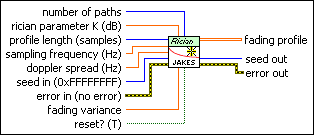
 |
profile length specifies the number of complex-valued fading profile samples (having Rician-distributed envelopes) to generate. The default is 1,000. |
||||||
 |
sampling frequency specifies the system sampling rate, in hertz. This rate is the product of the symbol rate × samples per symbol. The default is 1.0. |
||||||
 |
doppler spread specifies the desired input Doppler spread f m of the channel, in hertz. The default is 100.00 mHz. This parameter denotes the measure of the spectral broadening caused by the time rate of change of the channel. Doppler spread is defined as the range of frequencies over which the received Doppler spectrum is essentially nonzero. When a pure sine tone at frequency f c is transmitted, the received signal spectrum, called the Doppler spectrum, has components in the range (f c – f m) to (f c + f m). The Doppler spread is related to the mobile velocity v, carrier frequency f c, and the speed of light c by the relation f m = v f c/c.
|
||||||
 |
seed in specifies the initial state for generating the fading profile. If seed in is set to –1, the generated fading profile is randomly chosen during every call when reset? is set to TRUE. Otherwise, the generated fading profile returns the same set of fading coefficients when reset? is set to TRUE. The seed in value is used only for the first call or when reset? is set to TRUE. The default is –1. |
||||||
 |
number of paths specifies the number of paths in the simulated multipath channel. A fading profile is generated for each of these paths. |
||||||
 |
rician parameter K specifies the desired ratio,in dB, of the dominant line-of-sight (LOS) path to the scattering component. A large positive value of K represents a strongly additive white Gaussian noise channel, while a large negative value of K represents a Rayleigh fading (predominantly scattering) channel. Mathematically, the Rician parameter K is defined as K (dB) = 10 × log{Power[LOS component]/Power[scattering component]} The Rician fading profile is generated by adding a DC specular component to a Rayleigh distributed scattering component. var denotes the requested fading variance — the variance of the underlying Rayleigh fading profile. The amplitude of the specular DC component equals
By varying K, you can control the extent of the scattering component relative to the LOS component of fading. For a strongly Gaussian channel, K approaches infinity, while K < 0 indicates a strongly scattering (Rayleigh fading) channel. The default is 0 dB. |
||||||
 |
fading variance specifies the desired variance of the complex-valued Rician distributed fading profile. The default is 1.0. |
||||||
 |
reset? specifies whether the fading profile generation is reset on subsequent calls to this VI. When reset? is set to TRUE, fading profile generation is reset on every call to this VI. Set reset? to FALSE to continue generating the fading profile from the previous iteration on subsequent calls. The default is TRUE. |
||||||
 |
error in (no error) can accept error information wired from previously called VIs. Use this information to decide if any functionality should be bypassed in the event of errors from other VIs. Right-click the front panel error in control and select Explain Error or Explain Warning from the shortcut menu for more information about the error.
|
||||||
 |
fading profile returns a two-dimensional array, for each path, of complex-valued coefficients of the generated fading profile. The number of rows corresponds to the number of paths in the channel, and the number of columns is equal to the profile length. Wire this parameter to the MT Apply Fading Profile VI to apply this fading profile to a baseband I/Q signal. |
||||||
 |
seed out returns the internal state of the VI at the end of generation of the fading profile for the current iteration. |
||||||
 |
error out passes error or warning information out of a VI to be used by other VIs. Right-click the front panel error out indicator and select Explain Error or Explain Warning from the shortcut menu for more information about the error.
|
MT Rayleigh Selective Fading profile (Gans)
This polymorphic instance generates a selective-fading profile for the multipath channel. The envelope for each path statistically obeys the Rayleigh distribution implemented using the Gans fading model.
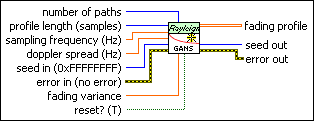
 |
profile length specifies the number of complex-valued fading profile samples (having Rayleigh-distributed envelopes) to generate. The default is 1,000. |
||||||
 |
sampling frequency specifies the system sampling rate, in hertz. This rate is the product of the symbol rate × samples per symbol. The default is 1.0. |
||||||
 |
doppler spread specifies the desired input Doppler spread f m of the channel, in hertz. The default is 100.00 mHz. This parameter denotes the measure of the spectral broadening caused by the time rate of change of the channel. Doppler spread is defined as the range of frequencies over which the received Doppler spectrum is essentially nonzero. When a pure sine tone at frequency f c is transmitted, the received signal spectrum, called the Doppler spectrum, has components in the range (f c – f m) to (f c + f m). The Doppler spread is related to the mobile velocity v, carrier frequency f c, and the speed of light c by the relation f m = v f c/c.
|
||||||
 |
seed in specifies the initial state for generating the fading profile. If seed in is set to –1, the generated fading profile is randomly chosen during every call when reset? is set to TRUE. Otherwise, the generated fading profile returns the same set of fading coefficients when reset? is set to TRUE. The default is –1. |
||||||
 |
number of paths specifies the number of paths in the simulated multipath channel. A fading profile is generated for each of these paths. |
||||||
 |
fading variance specifies the desired variance of the complex-valued Rayleigh distributed fading profile. The default is 1.0. |
||||||
 |
reset? specifies whether the fading profile generation is reset on subsequent calls to this VI. When reset? is set to TRUE, fading profile generation is reset on every call to this VI. Set reset? to FALSE to continue generating the fading profile from the previous iteration on subsequent calls. The default is TRUE. |
||||||
 |
error in (no error) can accept error information wired from previously called VIs. Use this information to decide if any functionality should be bypassed in the event of errors from other VIs. Right-click the front panel error in control and select Explain Error or Explain Warning from the shortcut menu for more information about the error.
|
||||||
 |
fading profile returns a two-dimensional array, for each path, of complex-valued coefficients of the generated fading profile. The number of rows corresponds to the number of paths in the channel, and the number of columns is equal to the profile length. Wire this parameter to the MT Apply Fading Profile VI to apply this fading profile to a baseband I/Q signal. |
||||||
 |
seed out returns the internal state of the VI at the end of generation of the fading profile for the current iteration. When reset? is set to FALSE, this state is used to continue the fading profile generation at the beginning of the next iteration. |
||||||
 |
error out passes error or warning information out of a VI to be used by other VIs. Right-click the front panel error out indicator and select Explain Error or Explain Warning from the shortcut menu for more information about the error.
|
MT Rayleigh Selective Fading profile (Jakes)
This polymorphic instance generates a Rayleigh selective-fading profile for the multipath channel. The envelope for each path statistically obeys the Rayleigh distribution implemented using the Jakes fading model.
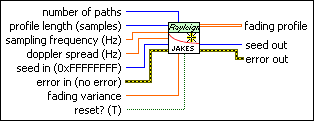
 |
profile length specifies the number of complex-valued fading profile samples (having Rayleigh-distributed envelopes) to generate. The default is 1,000. |
||||||
 |
sampling frequency specifies the system sampling rate, in hertz. This rate is the product of the symbol rate × samples per symbol. The default is 1.0. |
||||||
 |
doppler spread specifies the desired input Doppler spread f m of the channel, in hertz. The default is 100.00 mHz. This parameter denotes the measure of the spectral broadening caused by the time rate of change of the channel. Doppler spread is defined as the range of frequencies over which the received Doppler spectrum is essentially nonzero. When a pure sine tone at frequency f c is transmitted, the received signal spectrum, called the Doppler spectrum, has components in the range (f c – f m) to (f c + f m). The Doppler spread is related to the mobile velocity v, carrier frequency f c, and the speed of light c by the relation f m = v f c/c.
|
||||||
 |
seed in specifies the initial state for generating the fading profile. If seed in is set to –1, the generated fading profile is randomly chosen during every call when reset? is set to TRUE. Otherwise, the generated fading profile returns the same set of fading coefficients when reset? is set to TRUE. The seed in value is used only for the first call or when reset? is set to TRUE. The default is –1. |
||||||
 |
number of paths specifies the number of paths in the simulated multipath channel. A fading profile is generated for each of these paths. |
||||||
 |
fading variance specifies the desired variance of the complex-valued Rayleigh distributed fading profile. The default is 1.0. |
||||||
 |
reset? specifies whether the fading profile generation is reset on subsequent calls to this VI. When reset? is set to TRUE, fading profile generation is reset on every call to this VI. Set reset? to FALSE to continue generating the fading profile from the previous iteration on subsequent calls. The default is TRUE. |
||||||
 |
error in (no error) can accept error information wired from previously called VIs. Use this information to decide if any functionality should be bypassed in the event of errors from other VIs. Right-click the front panel error in control and select Explain Error or Explain Warning from the shortcut menu for more information about the error.
|
||||||
 |
fading profile returns a two-dimensional array, for each path, of complex-valued coefficients of the generated fading profile. The number of rows corresponds to the number of paths in the channel, and the number of columns is equal to the profile length. Wire this parameter to the MT Apply Fading Profile VI to apply this fading profile to a baseband I/Q signal. |
||||||
 |
seed out returns the internal state of the VI at the end of generation of the fading profile for the current iteration. |
||||||
 |
error out passes error or warning information out of a VI to be used by other VIs. Right-click the front panel error out indicator and select Explain Error or Explain Warning from the shortcut menu for more information about the error.
|
Details
The selective fading profile instances of the MT Generate Fading Profile VI generate Rayleigh or Rician distributed fading profiles for the specified number of paths based on the Jakes or Gans model. The generated fading profile is a two-dimensional array in which the number of rows is equal to the number of paths, and the number of columns is equal to the profile length. The generated profile is passed to the MT Apply Fading Profile VI.
Fading profiles can be characterized as multiplicative models that attenuate the magnitude and phase of the transmitted modulated I/Q baseband signal. The faded waveform can be used to test receiver immunity to fading channels. This VI models the following fading profile distributions:
-
Rayleigh—Describes a flat-fading channel characterized by a single-tap impulse response with a time-varying envelope that is
Rayleigh-distributed. This model describes the statistical time-varying nature of the received envelope
of a flat fading channel or the envelope of an individual multipath component. The Rayleigh distribution
has a probability density function (PDF) given by the following equation:

where r is the specified fading variance.
-
Rician—Describes a time-varying channel with an envelope that follows a Rician distribution.
The channel can be characterized by a single-tap impulse response comprising a dominant line-of-sight
(LOS) path superimposed on a random multipath. The limiting case of a Rician fading channel
(when the LOS path is much weaker than the random multipath) is the Rayleigh fading channel.
The Rician distribution is given by

where A denotes the peak amplitude of the dominant signal, I 0 ( ) denotes the modified Bessel function of the first kind and zero-order, and r is the specified fading variance.
The VI implements the Rayleigh/Rician fading profiles using two methods, the Jakes model and the Gans model. Each model is implemented by separate instances of this polymorphic VI.
-
Jakes—Deterministic method that simulates time-correlated Rayleigh fading waveforms. The model assumes that N equal-strength rays arrive at a
moving receiver with uniformly distributed arrival angles, such that ray n experiences a Doppler shift defined by the following equation:

where
 , and
, and represents the arrival angle of the ray n.
represents the arrival angle of the ray n. - Gans—Generates the Rayleigh fading profile by passing quadrature Gaussian I/Q components through a Doppler filter with a U-shaped power spectral density profile. For the selective fading model, the implementation ensures that the generated fading profile for all paths is uncorrelated.

 f
m (known as the coherence time) is the
time duration over which the channel impulse response is essentially invariant.
f
m (known as the coherence time) is the
time duration over which the channel impulse response is essentially invariant.



